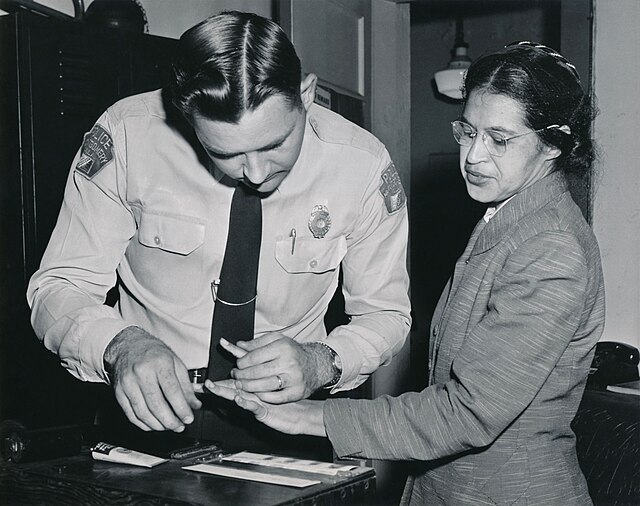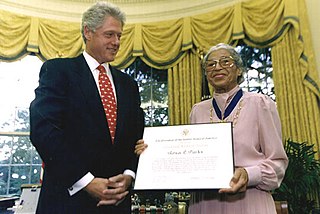African-American civil rights activist (1913-2005) From Wikipedia, the free encyclopedia
Rosa Louise McCauley Parks (February 3, 1913 – October 24, 2005) was an African-American civil rights activist. She was called "the mother of the Modern-Day American civil rights movement" and "the mother of the freedom movement".
Rosa Parks | |
|---|---|
 Parks in 1955, with Martin Luther King Jr. in the background | |
| Born | Rosa Louise McCauley February 4, 1913 Tuskegee, Alabama, U.S. |
| Died | October 24, 2005 (aged 92) Detroit, Michigan, U.S. |
| Resting place | Woodlawn Cemetery, Detroit |
| Occupation | Civil rights activist |
| Known for | Montgomery bus boycott |
| Movement | Civil Rights Movement |
| Spouse(s) | Raymond Parks (m. 1932; died 1977) |
| Signature | |
Parks is best known for what she did in her home town of Montgomery, Alabama on December 1, 1955. While she sat in a seat in the middle of the bus, the bus driver told her to move to the back of the bus so a white passenger could take the seat in the front of the bus and she responded with no. Her refusal to get up led to her arrest but it also inspired many colored people to stand up and fight against racism and discrimination.
During this time, when there were no white seats for white people, black people were told to get up out of their seat. Parks refused to move. She was a member of the local chapter of National Association for the Advancement of Colored People (NAACP). Like so many others she was tired of being treated as a lower class person because of the color of her skin.
She was arrested. This led to the Montgomery bus boycott. The boycott lasted 381 days. This caused a change in the law. After that, black people were able to sit wherever they wanted to on the bus. Her refusal to let others treat her differently was an important symbol in the campaign against racial segregation.
Rosa Parks was born in Montgomery, Alabama, on February 4, 1913.[1] Her parents were James and Leona McCauley.[1] She was mainly of African ancestry. One of her great-grandfathers was Scots-Irish and went to Charleston, South Carolina as an indentured servant.[2]
Her father left home to find work when Rosa was 2 years old.[3] Her mother taught school in another town. Rosa and her brother Sylvester were brought up by their grandparents.[3]
Rosa started school in 1919 when she was 6 years old. At that time, schools were segregated. There were black schools and white schools. Later, Parks remembered how buses took white students to their school, but black students had to walk to theirs:
I'd see the bus pass every day... But to me, that was a way of life; we had no choice but to accept what was the custom. The bus was among the first ways I realized there was a black world and a white world.[4]
In 1924 she went to the Montgomery Industrial School for Girls in Montgomery, Alabama.[5] After 5 years, she left school and went to work in a shirt factory.[5] She also took care of her grandmother.
On December 1, 1955, Parks got onto a city bus to go home after work.[6] She paid her 10¢ and sat down in the first row of seats behind the painted line on the floor which marked the black section.[lower-alpha 1] After several stops, more white passengers got on the bus. The bus driver ordered Parks and three other black people to give up their seats so the white people could sit down. The other three moved to the back of the bus, but Parks slid over to the window.[8] She said she was following the law by sitting in the right section. Later, she said that when she was told to go to the back of the bus, "I thought of Emmett Till and I just couldn't go back."[9] (Till was a black 14-year-old boy who was lynched in Mississippi about three months earlier.)[10]
The driver stopped the bus and called the police.[6] Two police officers arrested Parks and took her to jail for violating Alabama's bus laws.

Her mother called upon Edgar Nixon to bail her out. Nixon was the president of the local NAACP chapter. Nixon knew the danger Parks was in and immediately arranged her bail.[6]
The local NAACP had been looking for a test case to challenge the bus segregation laws.[6] Parks was a respected working woman. She was well-spoken, and her case would be a good way to challenge the law. It was decided that on December 5, a boycott of all the buses in Montgomery would be held.[11]
The word was spread throughout the black community of the intended bus boycott. Black ministers told their congregations to support the boycott.[12] On Monday, December 5th, Rosa Parks had to appear in court.[13] This was also the first day black riders would stay off the Montgomery buses. The streets of Montgomery were filled with black people walking to work.[13] Black children walked to school.[13] That same morning, all Montgomery buses were assigned two motorcycle policemen to guard against any black gangs intimidating riders.[14] There were no black gangs. The black community simply cooperated with the boycott. The buses remained empty all day. White riders fearing trouble stayed off the buses as well.[14]
In addition to the charge of violating the bus laws, Parks was also charged with disorderly conduct. Her trial was quick, only about 30 minutes. The court found her guilty of all charges and fined her $14.[15] The boycott continued.
Parks appealed her conviction. Her attorney, Fred Gray, and others in the NAACP brought an appeal named Browder v. Gayle.[lower-alpha 2][16] The appeals court ruled on June 19, 1956 in favor of the black citizens of Montgomery. But the city appealed the decision.
On September 13, 1956, the Supreme Court of the United States upheld the lower court. The bus boycott ended.[16] It had lasted 381 days.[17] Black citizens of Montgomery could ride the buses and sit where they chose.[16] Rosa Parks rode the bus again on December 21, 1956.[18] This time it was an integrated bus. Ironically, she had the same bus driver who had her arrested the year before. In an interview, Parks said "He didn't react (pause) and neither did I".[18]
Rosa Parks was a heroine of the black community. While she didn't do it alone, her actions sparked a fire that led to great changes.[19]
After the Montgomery Bus Boycott, Parks went through many difficulties. She lost her job at the department store. Her husband was forced to quit his job.
In 1957, Parks and her husband left Montgomery for Hampton, Virginia to find work. In Hampton, Parks found a job as a hostess in an inn at Hampton Institute, a historically black college.
Later, Parks and her husband moved to Detroit, Michigan. Parks continued to work as an activist. For years, she worked for United States Congressman John Conyers. After that, she worked as an activist against apartheid in South Africa. She also opened a center in Detroit that gave advice to black youth about careers and job opportunities.[20]

In 1999, President Bill Clinton awarded Parks a Congressional Gold Medal. This is the United States' highest honor (most important award) for civilians. When he gave her the award, President Clinton said:
We must never ever, when this ceremony is over, forget about the power of ordinary people to stand in the fire for the cause of the human dignity. [20]
Parks died on October 24, 2005, at her home in Detroit due to dementia.[21] On October 30, her casket lay in state in the United States Capitol.[20] This is a great honor for people in the United States.
Seamless Wikipedia browsing. On steroids.
Every time you click a link to Wikipedia, Wiktionary or Wikiquote in your browser's search results, it will show the modern Wikiwand interface.
Wikiwand extension is a five stars, simple, with minimum permission required to keep your browsing private, safe and transparent.